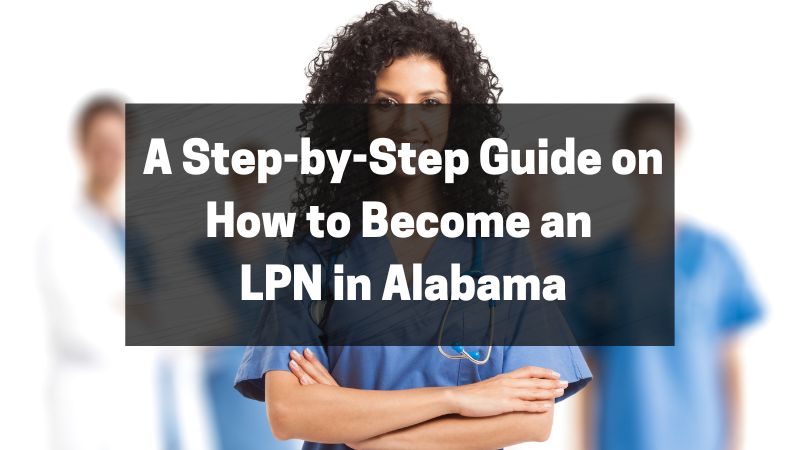A career in nursing is an excellent choice! And deciding to become an LPN is great!
It’s a stable, well-respected profession with a lot of earning potential. You can find some great career opportunities, too!
Yes, it’ll take some work — there’s no getting around that — but nothing’s impossible as long as you know what to do.
That said, it’s easy to get confused about how to become an LPN — after all, there are subtle differences between the processes of different states.
But don’t worry — we’ve got you covered!
The good news is our guide walks you through the steps of how to become an LPN in Alabama. What’s better is that we kept it simple, so you’ll only go through four stages.
We even included some questions you might have. These include the following:
- How much do LPNs earn in Alabama?
- Where do LPNs typically work?
- Is Alabama a compact state? What does that mean for LPNs?
That’s a lot of ground to cover, so let’s not wait any longer.
Are you ready to begin? Here we go!
How to Become an LPN in Alabama in 4 Steps
If you’re anxious about what’s in store for you, don’t be. The path to becoming a Licensed Practical Nurse isn’t complex.
We’ve outlined the following steps:
- Comply with the educational requirements
- Apply for your LPN license
- Enter the Alabama workforce
- Keep your license active
Let’s break those steps down in detail.
Step #1: Comply with the Educational Requirements
The first thing we’ll tackle is getting your education requirements out of the way. Unlike RNs, you don’t need to complete a degree.
However, all aspiring LPNs need to complete a board-accredited program, which you can typically complete within a year. There are currently 20 approved programs in Alabama.
Although each one may have a different set of requirements, the most common are the following:
- Having the minimum ACT scores
- A cumulative high school GPA of at least 2.5 or a GED
- A clean criminal record
Choosing a Nursing Program
With so many schools offering approved nursing programs, it’s best to consider multiple factors to help you find the best one for you.
Think about the following areas:
- Pre-requisites: Besides those mentioned above, some schools have more specific requirements before you qualify for enrollment. These may include completing specific subjects or passing the TEAS. You’ll have to deal with those first if you aren’t compliant.
- Cost: Most LPN programs cost anywhere between $5,000 to $10,000. In Alabama, it’s best to have around $8,000 ready.
- Faculty: Do your research and see if their teaching staff have LPN experience. This way, they can provide you with practical advice on more than just the curriculum content.
- Student Support: Some schools offer students financial aid. It may help you with your tuition. Others offer test prep, increasing your readiness level for the NCLEX-PN.
- NCLEX-PN Pass Rates: The ABN shows the annual NCLEX pass rate of each approved LPN program provider. It gives you an idea about how schools prepare their graduates for the exam.
Remember, when it comes to your LPN nursing program, getting into your ideal school makes a significant difference.
Step #2: Apply for Your LPN License
There are two ways to apply for your LPN license in Alabama — by examination or endorsement. The first is for those who just completed an approved nursing program, while the second is for LPNs with active licenses from non-compact states.
You have to go through either route before you can start practicing in the Heart of Dixie. Let’s break the steps down for each.
License by Examination
Aspiring LPNs who recently completed a board-approved LPN program can earn their Alabama license through the following steps:
- Complete your application to the Alabama Board of Nursing. It’s best to have the following information handy when you do this:
- Your Social Security Number
- Documents proving your U.S. citizenship or legal presence
NOTE: Remember that you must submit these with a filled-out checklist — there’s a different one for citizens and non-citizens.
- Your nursing school’s program code
NOTE: You can get it from them or look it up at Pearson VUE
- Education reports from a Credential Evaluation Service from CGFNS, ERES, or IERF
NOTE: This is for foreign-educated applicants only
- A detailed written explanation for any regulatory questions answered with a yes
- Pay the appropriate fees:
- $100 application fee
- $50 for a temporary license (only if you select this option)
- $3.50 transaction fee
- Have your nursing school send your official transcript to transcripts@abn.alabama.gov.
- Register to Pearson VUE. You have to pay a separate testing fee worth $200.
Once the ABN approves all your documents, you’ll receive an Authorization to Test notice (ATT). It will have your testing instructions, and you must bring it to your testing facility.
- Take the NCLEX-PN.
The ABN will mail your results directly — expect to receive them within three to five days. However, you can also view your results online 24 to 48 hours after you take the NCLEX-PN.
If you don’t pass the NCLEX on your first try, don’t worry too much about it. You can retake the exam after 45 days.
License by Endorsement
If you already have an active LPN license and want to practice in Alabama, you can undergo the licensure by endorsement.
It begins the same way — completing an online application to the ABN and submitting the necessary documents. After that, you’ll need to do the following:
- Submit proof that you’ve completed 24 contact hours within the last two years to comply with Alabama’s LPN license renewal requirements.
- Verify your license through Nursys. If your state isn’t in its database, contact your board and have them send verification to the ABN.
- Submit your fingerprinting information.
Step #3: Enter the Alabama Workforce
You deserve a pat on the back — you have your LPN license!
Now that you can officially practice in Alabama, the next step is to find your first nursing job. Here are some tips to help you out:
- Don’t be afraid to use your connections. Joining nursing organizations or reaching out to former classmates and professors can help your job search. You can go as far as asking the facility where you completed your clinical training for a referral.
- Explore your options. Don’t limit yourself to nursing homes. Although most LPNs work there, others find employment elsewhere. These may include hospitals, doctors’ offices, or even government agencies.
- Customize your CV. Just because you don’t have prior experience doesn’t mean you can’t have an impressive resume. Do your research about your shortlist of potential employers. Don’t send the same version to every facility — personalize it based on what openings you find.
Step #4: Keep Your License Active
Like all licenses, yours will eventually expire. One thing you should be mindful of is when you need to renew it.
All LPN licenses in Alabama expire on odd-numbered years, requiring you to complete the renewal process biennially.
However, remember that this applies regardless of when you first received your license. For example, if you got it on June 21, 2021, it expires in the same year — on December 31.
You can start working on your renewal as early as September 1 on a renewal year. LPNs with single-state licenses pay a $100 fee. Those with multistate ones spend $200.
To qualify, you must earn 24 contact hours every 24 months. All of these are electives, so you have the freedom to choose courses you feel will benefit you most.
Frequently Asked Questions About Becoming an LPN in Alabama
Now that we’ve talked about the four steps to becoming an LPN, let’s discuss important questions that have to do with being an LPN in Alabama.
How much do LPNs earn in Alabama?
According to the BLS, the average salary of LPNs as of May 2021 is $51,850.
Unfortunately, if you’re in Alabama, expect a lower salary range. LPNs earn an average of $41,540 — that’s around 19% lower than the national average.
However, note that your salary is affected by your location. For example, working in Hoover, Fairhope, or Huntsville may allow you to earn more since these are the highest-paying cities in the state.
Your salary can also increase depending on what facility you work in, if you have more experience, and if you gain certifications.
Where do LPNs typically work?
The Bureau of Labor Statistics puts 38% of LPNs in nursing and residential care facilities.
However, others work in the following healthcare facilities:
- 15% are in hospitals, whether state, local, or private institutions
- 13% are in physicians’ offices
- 13% are in home healthcare services
- 6% are in government agencies
Is Alabama a compact state? What does that mean for LPNs?
Yes, Alabama is a compact state, which means LPNs with multistate licenses can practice in other areas that are part of the eNLC (enhanced nursing licensure compact).
They don’t have to apply for a license in other compact states, which makes it more convenient. It also gives them more employment opportunities.
Some Final Words
We meant it when we said we’ll give you a comprehensive guide. Now you have all the necessary information to launch your LPN career — from finding the right school, getting your first job, and renewing your license.
A roadmap can help you avoid feeling lost and overwhelmed, so use it wisely! You can always check out ABN’s website if you want more resources.
Good luck!

